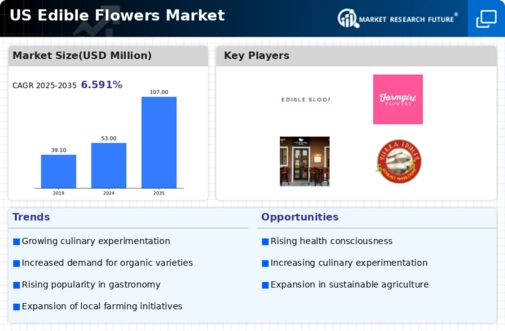Increased Use in Beverage Industry
The edible flowers market is experiencing a surge in the use of edible flowers in the beverage sector. Mixologists and beverage manufacturers are increasingly incorporating flowers into cocktails, teas, and health drinks to create unique flavors and visual appeal. This trend is particularly evident in craft cocktail bars, where the use of edible flowers can elevate the drinking experience. Market analysis indicates that the beverage segment of the edible flowers market is expected to grow by approximately 15% annually, reflecting a broader trend towards innovative and artisanal beverage offerings. This growth suggests that the edible flowers market will continue to expand as consumers seek novel drinking experiences.
Influence of Social Media on Food Trends
The edible flowers market is significantly influenced by social media platforms, where visually appealing food content thrives. Influencers and food bloggers often showcase dishes adorned with edible flowers, creating a buzz around their use. This social media exposure has the potential to drive consumer interest and demand, particularly among younger demographics who are active on these platforms. As a result, the edible flowers market is likely to see increased sales as more consumers are inspired to recreate these visually stunning dishes at home. The impact of social media on food trends suggests a promising future for the edible flowers market.
Rising Demand for Aesthetic Food Presentation
The edible flowers market is experiencing a notable increase in demand driven by the growing trend of aesthetic food presentation. Chefs and home cooks alike are increasingly incorporating edible flowers into their dishes to enhance visual appeal. This trend is particularly pronounced in upscale dining establishments, where presentation is paramount. According to recent data, the market for edible flowers in the US is projected to grow at a CAGR of approximately 8% over the next five years. This growth is indicative of a broader shift towards visually appealing culinary experiences, suggesting that the edible flowers market will continue to thrive as consumers seek unique and attractive food options.
Expansion of Organic and Locally Sourced Products
The edible flowers market is witnessing a significant shift towards organic and locally sourced products. As consumers become more health-conscious, there is a growing preference for organic edible flowers, which are perceived as safer and more nutritious. The organic segment of the edible flowers market is expected to account for over 30% of total sales by 2026. This trend aligns with the increasing demand for sustainable and environmentally friendly food options. Local sourcing not only supports community farmers but also reduces the carbon footprint associated with transportation. Consequently, the edible flowers market is likely to benefit from this dual focus on organic and local products.
Growing Interest in Culinary Education and Workshops
The edible flowers market is benefiting from a growing interest in culinary education and workshops focused on the use of edible flowers. Culinary schools and local cooking classes are increasingly offering courses that teach participants how to incorporate edible flowers into their cooking. This educational trend not only raises awareness about the versatility of edible flowers but also encourages their use in everyday cooking. As more individuals become educated about the culinary potential of these flowers, the demand for them is likely to increase. This suggests that the edible flowers market will see a boost as culinary enthusiasts seek to experiment with new ingredients.















Leave a Comment